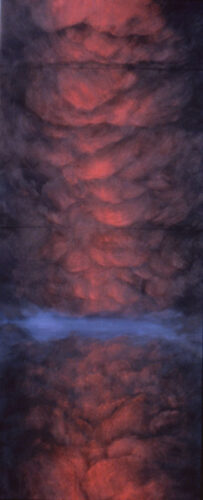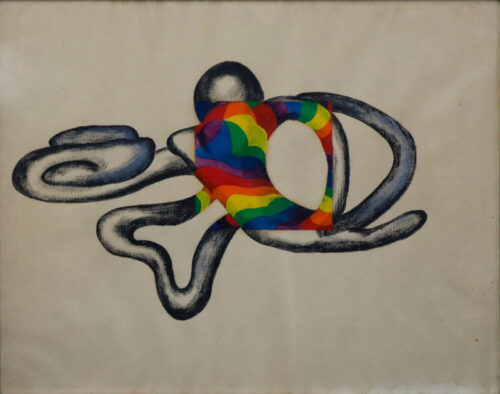Light and contrast are two of the simplest building blocks of a work of art. It is then telling when an artist can take these fundamental concepts and create breathtaking pieces with a profound depth of meaning. For sixty years, Karen Gunderson has done just that. She is best known for her iconic black paintings, which began in 1988, depicting natural elements like water, mountains, sunflowers, and clouds, as well as portraits of royalty and political leaders.
While it may be tempting to write off the idea of black-on-black paintings as derivative of the long history of artists making white-on-white paintings—Kazimir Malevich, Robert Ryman, Agnes Martin, Joseph Albers, etc.—, there is something special hiding within Gunderson’s work that can only be appreciated in person or through video documentation. A standard installation photograph does not suffice. Gunderson’s unique approach brings what might otherwise be a traditional static painting to life. As the viewer walks past one of these paintings the light shifts, giving the sense that the art is active. Because of this, Gunderson’s paintings have been described as cinematic. The effect comes from how light reflects off the surface of the paintings, which are created using four shades of black and textural brushwork.
In a 2022 video produced by Erin Cluley Gallery in Dallas, Gunderson speaks about her work, explaining, “Black is the biggest contrast to light, and what you’re looking at is light, really, reflecting. For me, that’s always a sign of hope.”
Gunderson’s black paintings came out of a tragic moment. The work began when, in the late 1980s, she was working on an exhibition for her dealer, Aladar Marberger, who had recently been diagnosed with AIDS. Though he participated in experimental treatments for the disease, he ultimately died in 1988. In the last years of his life, he courageously spoke out about the social stigma related to HIV/AIDS and continued to live a life filled with friends and art. Some of the artists closest to him, including Elaine de Kooning, memorialized Marberger in their work. Gunderson created cloud paintings in his memory, with dramatic lighting shaped by the use of black underpaintings.
In a 2020 interview with Noah Becker for Whitehot Magazine, Gunderson recalled, “I wanted to do something special for him – so I made a giant sunset. I made all of the skies various blues, and then I painted the clouds with black paint to show their forms. I let that dry and then I went into them with the colors to look like they were lit… The black paintings came out of those under-paintings of the forms of the clouds.”
Gunderson’s interest in nature as a subject for her art began when she was a graduate student at the University of Iowa. Though she worked with a traditional subject matter, she experimented with various media, including plexiglass, polyresin, and super-8 film. While working on her MFA, Gunderson studied with Modernist landscape, still life, and figure painter Stuart Edie and innovative interdisciplinary artist Hans Breder. Because Breder created the Intermedia Program at the University of Iowa, Gunderson became the first person to receive that degree in the U.S. Also, during her time at the University of Iowa, Gunderson met neurophysiologist Steve Fox, who introduced her to “brain forms,” which became a new focus in her work. These anatomical renderings were a precursor for the artist’s next subject matter, a series of cloudscapes. Her cloud paintings of the 1970s and 1980s are dreamy and sumptuous. At times the work features light airy clouds that fill a bluish sky, and sometimes the works are more abstract, with a singular cloud form filling most of the canvas. Both the “brain forms” and cloudscapes use contrast and light to produce undulating forms, a style that Gunderson continues to build upon with her series of black paintings.
Most recently, Gunderson’s focus has been on monochromatic black seascapes. The captivating paintings hold an air of mystery and danger. Like her other signature black paintings, the waves seem to move as the viewer walks around the painting. And similar to Gunderson’s mountains, the ocean paintings may contain a deeper meaning. While water can be seen as a metaphor for cleansing, renewal, and life, the darkness of the paintings alludes to an ominous nature beneath the surface. Is there something lurking in the depths of the waters that the viewer is not privy to? Are the close-up paintings of choppy waters depicting a rising tide, (whether a reference to climate change or the political landscape of the U.S.)? The dynamic waves are relatively calm, they are not crashing or breaking, but the water is not still.
Over the years, Gunderson has made paintings of a political nature, though at times she has been subtle with her approach. In the early 2000s, she painted a series of Tibetan mountains in response to China’s imprisonment of Buddhist monks. A viewer might not make that direct connection when seeing the paintings hanging in a gallery. However, the message behind Gunderson’s black paintings of political leaders was slightly more overt. The paintings began during George W. Bush’s presidency and were sparked by his handling of and response to 9/11. Rather than creating negative imagery around President Bush, Gunderson decided to elevate historical figures whom she felt had been effective leaders in the past. These portraits include a variety of leaders from various times and regions, such as Christian X, King of Denmark; Boris III, Tsar of Bulgaria; Alfred the Great, King of the West Saxons; Wu Zetian, Empress of China; and ultimately President Barack Obama; among others.
Throughout her career, Gunderson has exhibited across the U.S. and internationally. She has had solo shows and been a part of group exhibitions at various institutions, including the Biennale Internazionale Dell’Arte Contemporanea, Florence, Italy; the Circulo de Bellas Artes, Madrid, Spain; The Museum of Fine Arts Houston, Milwaukee Art Museum, The Bronx Museum, Bronx, NY, The Sol Lewitt Collection, The Holocaust Museum, Houston, TX, the National Museum of Gdansk, Poland. Minneapolis Institute of Art, MN; The Four Seasons Hotel, Orlando FL, Fischbach Gallery, New York, NY; Donahue/Sosinski Art, New York, NY; Racine Art Museum, Racine, WI; Additionally, her work has been featured in some of the top art fairs, such as Art Basel, Art Miami, the Armory Show, and the Dallas Art Fair. Beyond presentations of her work, Gunderson has also received numerous honors and awards, most notably the Lorenzo il Magnifico award in painting at the 2001 Florence Biennale, and in 2020 she was honored with the Anonymous Was a Woman prize.
With a six-decade-long career, Gunderson is celebrating her 80th birthday this year with a retrospective at Erin Clulely Gallery. Everything the Light Touches: Sixty Years of
Karen Gunderson brings together works across Gunderson’s oeuvre illustrating both the connectivity throughout her practice and how she has experimented, shifted, and evolved as an artist. The exhibition opens on Saturday, March 30, and runs through Saturday, May 4. An opening reception will take place on Friday, April 5, from 6:00 p.m. to 9:00 p.m.
Additionally, as part of the programming around the Dallas Art Fair, Gunderson will be in dialogue with Maggie Adler, curator at the Amon Carter Museum of American Art. The talk will take place at the Nasher Sculpture Center on Thursday, April 4, at 3:00 pm.




